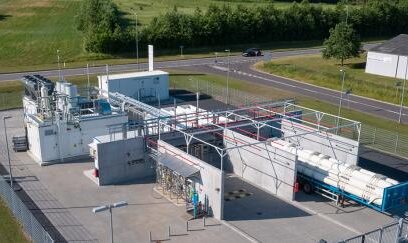Natural Gas Reforming: The Most Common but Polluting Option
Let’s start with the most common method: natural gas reforming, also known as steam methane reforming. This process involves mixing natural gas (mostly methane) with high-temperature steam to produce hydrogen and carbon dioxide (CO2).
Advantages: This method is widely used because it is relatively cheap and well-practiced since decades ago. It accounts for about 95% of global hydrogen production.
Disadvantages: The main drawback? It generates significant amounts of CO2, contributing to climate change. Hydrogen produced this way is often referred to as “grey” hydrogen, with a considerable carbon footprint. Economically, the price of H2 is also tied to the gas market and global dependencies.
Water Electrolysis: A Clean Solution but Currently Costly
Water electrolysis is a method that has garnered a lot of interest, especially for producing “green” hydrogen. The process is simple: electricity is used to split water (H2O) into hydrogen (H2) and oxygen (O2). If the electricity comes from renewable sources, the hydrogen produced is completely carbon-free.
Advantages: Electrolysis allows the production of hydrogen without emitting CO2 when powered by renewable energy, making it an appealing option for a sustainable future.
Disadvantages: The main challenge is cost. Electrolysis is still expensive, primarily because it requires a lot of electricity. Additionally, electrolyzers, the devices used for this process, are still costly to manufacture.
Coal Gasification: An Older but Polluting Method
Coal gasification is an older technique that involves heating coal in the presence of oxygen and steam to produce a mixture of gases (including hydrogen) and CO2.
Advantages: This method can produce large quantities of hydrogen.
Disadvantages: Like natural gas reforming, this method is highly polluting, emitting significant amounts of CO2. It also relies on coal, a non-renewable and very polluting resource. Hydrogen produced by this method is often referred to as “black” or “brown” hydrogen, depending on the type of coal and process used.
Methane Pyrolysis: A Promising but Experimental Alternative
Methane pyrolysis is a newer, promising method. It involves heating methane to a very high temperature in the absence of oxygen, producing hydrogen and solid carbon (instead of CO2).
Advantages: This method could be an interesting alternative to traditional reforming because it doesn’t produce gaseous CO2.
Disadvantages: The technology is still under development and not yet ready for large-scale production. It also requires a significant amount of energy.
Other Methods: Exploring New Frontiers
There are other hydrogen production methods that are still under research or in experimental stages. For instance, biological processes (like fermentation), hydrogen from biomass, methane plasmalysis, photoelectrolysis, and thermochemical processes using organic and inorganic waste. These methods offer exciting prospects, but they still need to prove themselves before they can be used on a large scale.
Conclusion: What’s the Future of Hydrogen Production?
Hydrogen holds enormous potential for helping decarbonize our economy, but how we produce it is crucial. While current methods like natural gas reforming are widespread, they are not sustainable in the long term. This is why electrolysis, especially when powered by renewable energy, is generating so much interest. However, technologies like methane pyrolysis or biological production could also play a key role in the future.
The key is to continue innovating and investing in these technologies to make hydrogen production cleaner and more affordable. Who knows? Hydrogen might just be the key to a greener and more sustainable energy future!
HSL has developed a hydrogen carrier and focuses on storing and transporting only green fuel derived from renewable electricity. As chemically bonding hydrogen to silica (to produce Hydrosil) is energy-intensive, we aim to create this final molecule with minimal energy costs and optimal use, synchronized with the intermittency of renewable energy sources. This ensures compliance with European and international regulations on green fuels and derivatives while meeting the criteria for additionality and temporal correlation with renewable energy in the EU as well as internationally


